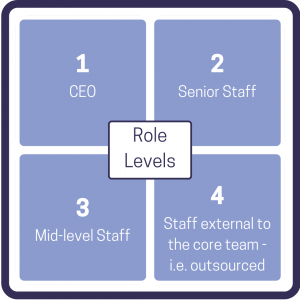As Agile Management Office is celebrating its 5th anniversary this month, I sat down and reflected on the start of my career as an entrepreneur and businesswoman. Listen to the Agile Ideas podcast episode on this topic with me here. Here goes…
Taking a trip down memory lane, I remembered some things I wish I had known when I started AMO business five years ago. I want to share the lessons that I learned which I believe would be valuable for anyone in business or intending on running one, but also lessons for other leaders. I learnt these lessons the hard way, that if I had have known before, would have saved me significant time, heartache, and headaches. So now I pass them on to you.
1.Decentralise and delegate
When I started out, I spent a lot of time trying to centralise the control and command of everything going on the business. As I gained more and more team members, it reached a point where I felt like I was needing to control everything that was going on with everyone and in the business overall. The issue is that you cannot be always in control and aware of absolutely everything. If you think about some of the most successful entrepreneurs in the world, you soon realise even they cannot possibly be across everything at the same time; it’s just not possible. There is simply not enough time, energy, or brain power for it, particularly as the business grows!
I learnt that having a decentralised business model is actually not a bad thing. But you must have clear processes, and guardrails in place for what can and can’t happen. You need to have general guidelines for your staff for them to know what is possible and what are the things that maybe needs your attention, your guidance, empathy, and potentially approval. There must be a balance between what you are controlling and what you can let go off. What this does is, it sets the boundaries, while also giving employees autonomy and freedom, instilling in them a sense of trust. This is vital for creating a strong company culture, which will ultimately allow you to focus your energy elsewhere, while providing support when needed.
One way I break up my business operations and roles are using a four-quadrant framework:

Quadrant one is everything that I, as a CEO and a founder, must be across that is actually something I’m to be accountable and have roles and responsibilities for.
Quadrant two includes my senior staff. This doesn’t just mean senior in terms of years’ experience or how long they’ve worked in the business. In fact, they are people that I would consider my 2IC’s, people that understand the way we work and have proven themselves as loyal and reliable over a long period of time.
Quadrant three is your mid-level staff that are not yet team leader or senior consultant level, but staff that are part of the close-knit team. While they may need more direction and oversight, they often can undertake a number of tasks independently. This might be your social media manager or your bookkeeper for example.
Quadrant four is completely relevant to those relationships or staff that you may bring in from time to time, such as copywriting. They are not part of your core team, but you contact them as needed. They’re the skills and resources, the things that you need to do in your business that you can completely outsource at the click of a finger and they don’t need to have much knowledge or IP of your business.
Doing this can really help you to give direction to your team, but also to give you a little bit of flexibility in terms of what it is you’re trying to control and what areas of your business that you’re able to let go of.
2. Have contracts with all staff members, even your family and friends
Another learning I gained relates to having efficient and effective contracts in place for all staff members. I was fortunate to have many family members, friends, and colleagues support my business with guidance and advice over the years. I am very grateful for all of their support! However, I will say that I wish I had known at the start of setting up a business that, no matter how amazing your relationship is with those people, you need to have solid, up to date contracts in place with them if they are engaged by your business to do work. This contract includes how you will work together, what sort of compensation they will receive, details around work responsibilities, and KPIs, with all that information documented. This is one of the most valuable things you can spend money on. Now, you need to get a lawyer to help you write that to ensure its right! There is government support out there that provides you access to human resource professionals that can help you write those contracts.
It really helps to protect key relationships that you don’t want to jeopardise, which can occur with friends or family because you don’t have an agreement in place, upfront. Similarly to a marriage where some people decide to contract a prenuptial agreement, your agreement with your colleagues, friends, family, or whoever it is that is supporting you and your business, needs to happen, protecting both of you. it’s not just about the business but it’s also about protecting that relationship and having absolute clarity, rather than trying to retrospectively put those in place.
3. Clarity is king– always find product-market-fit first
Even though most project goals and objectives are relatively straight-forward and defined in a project management plan, it’s rare to be involved in the goal-setting and the determination of metrics and higher-level strategy as it relates to the vision and mission of the business’ agenda. This was certainly the case in my corporate-world experience where my focus was more on executive delivery of strategic agendas set by management. However, now being an entrepreneur and having my own business, setting the direction and strategy needed to achieve it became a core part of my role. However, I did not have enough knowledge in this space, and I did not understand how organisational strategic objectives link into goals that link into metrics and that you need to continue to review and revise these based on performance.
The reason for my lack of clarity was not just because there was not a process in the business to define it clearly, because that is something that you can find an abundance of information online. Instead, I did not take the time to speak to potential customers about what they needed and how I would be able to provide that. Essentially, I hadn’t found or established my product-market-fit. I had assumed that because I was able to do really valuable work within the corporate space and was receiving positive feedback, that I’d be able to create my own consultancy and that those exact same requests would come through. Customers did start to trickle in, but it was slow at the beginning. I didn’t know exactly what customers wanted because I didn’t take the time to research and ask them whether or not this will be something they want.
Therefore, make sure you talk to your prospective customers first. Your prospective customers should be in the right demographic or industry or business type that you’re targeting and are people you would like to see buying your product or service. They don’t have to be the actual people purchasing from you, as your priority now is selling the idea and concept of your business.

If anything, you’re obtaining market research before going to market. Using that feedback, refine your goals and objectives for what you want to achieve. It can be daunting to plan your goals for years in advance, so starting with smaller tactical objectives, such as 3-month time spans, that lead you to a long-term vision will help to get you closer and make it more manageable. A useful tool here is the value proposition canvas as it will help you directly relate your market’s pains and gains and how your offerings eliminate pains and enhance customers’ gains.
4. Know your sales processes
Sales is one of most challenging departments of our business, and receiving many rejections can be disheartening, particularly when you have invested significant time and effort for a prospective client. To manage this, I’ve learnt the value of knowing your sales processes extremely well. This means having a clearly defined sales process, which you may not be able to do on your own immediately, but even taking the time to educate yourself on industry-relevant processes is a strong step in the right direction.
Defining a sales process can include how you identify prospective opportunities or customers, generate leads, and incorporate marketing here, and effectively take a customer through an entire sales process or sales funnel. To start off, think about putting yourself in the shoes of your potential customer and consider their journey. Map out what happens from their product and brand awareness to point of purchase when you deliver it for your customer and provide post-sale support.
This can be daunting, and it is very challenging. There’s so much to know about sales and it’s both an art and a science. I recommend getting some support in that space or even hiring a business development manager, or if you’re like me, bootstrap the whole way through. Investigate some online courses and programs or look at small business state government and federal government support.
5. Do not rush to automate
One mistake I made early on was subscribing to program after program after program to automate my business before even documenting clearly the processes within it. It can be really overwhelming trying to manage the various information streams, coming at you from HR, work cover, insurance, sales, finance, product development, legal, everything. Because of this, I had sought various software products to automate my processes, even though I was nowhere near the capacity, maturity, or size to require this.
Therefore, the lesson here is don’t try to automate processes that you don’t have clearly defined to begin with. You need to understand your processes and you need to consider whether it is even worth using technology for those processes or functions. Technology is great but can be used inefficiently, or paid for and not used, and setting it up can take much energy, time, and money from your business. Instead, think about what processes you need, break them up by functions within your business, and put them into an operational manual.
Certainly, if you spend hours a week doing something somewhat manually or laboriously, that software, like a customer relationship management tool or a marketing tool that takes you 30 minutes to complete tasks, then that’s a no brainer and it’s worth investing. However, don’t try to automate everything before you have clear processes. They don’t have to be highly detailed to start with; just begin with a very high-level framework, and you can continue to add to that.
I hope you’ve learnt from my mistakes! 🙂
In business, which can be very overwhelming and daunting, if you’re passionate about what you’re doing and you have a vision, and believe in your heart and business, and others believe in you too, then it makes the journey that little bit easier. But there is much to learn and taking your time to read through good books, marking them up, and trying to implement your learnings will always be beneficial.
Finally, another thing to consider is how much time you have. I like to focus on about one process a month. For example, this month AMO is focusing on continuous improvement for our sales processes, whereas last month it was continuous improvement for marketing processes. And if every month you continuously improve processes within your business, you will find that you will be far better off for it.

Does your business need some advice or guidance to get moving or to help you scale? Perhaps you have a challenge you are trying to address and need some advice and coaching? Let us have a chat!

